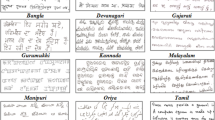Summary
The paper describes a newly presented hybrid method for high efficiency in script image feature extraction. The recognition rate was about 82% for very large number of scripts per class. However, it has reached even 100% in some cases with a smaller number of scripts per class. The system contains two projection-based methods for image characteristics extraction presented by very simple feature vectors and one image descriptor. A specially worked out thinning algorithm for the recognition system has simplified the feature extracting procedure as it provides a continuous one-pixel width skeleton of the script, which is essential for the simple-projection approach.
Access this chapter
Tax calculation will be finalised at checkout
Purchases are for personal use only
Preview
Unable to display preview. Download preview PDF.
Similar content being viewed by others
References
Saeed K., Niedzielski R., “Experiments on Thinning of Cursive-Style Alphabets,” Proceedings of International Conference on Information Technologies and ITESB’99, pp. 45–49, Minsk 1999.
Saeed K., “Text and Image Processing: Non-Interrupted Skeletonization,” Advances in Signal Processing and Computer Technologies, pp. 350–354, CSCC/IEEE, WSES Press: Crete 2001.
Saeed K., Rybnik M., Tabdzki M., “Implementation and Advanced Results on the Non-interrupted Skeletonization Algorithm,” CAIP’01, Lecture Notes in Computer Science, W. Skarbek (Ed.), pp. 601–609, LNCS 2124, Springer-Verlag Heidelberg 2001.
Chen Y.S., “The Use of Hidden Deletable Pixel Detection to Obtain Bias-Reduced Skeletons in Parallel Thinning,” IEEE Proceedings of International Conference on Pattern Recognition-ICPR’96, Vol.II-B, pp.91–95, Vienna’96.
Ahmed M., Ward R., “A Rotation Invariant Rule-Based Thinning Algorithm for Character Recognition,” IEEE Transactions on Pattern Analysis and Machine Intelligence, Vol.24, No.12, pp. 1672–1678, 2002.
Saeed K., “Image Analysis for Object Recognition,” Bialystok Technical University Press, 2004
Saeed K., “Computer Graphics Analysis: A Method for Arbitrary Image Shape Description,” MGV-International Journal on Machine Graphics and Vision, Polish Academy of Sciences, Vol.10, No.2, pp.185–194, 2001.
Fukunaga K., “Introduction to Statistical Pattern Recognition,” Academic Press, San Diego, California, 1990.
Kukharev G., “Biometric Systems-Methods and Approaches of Human Personality Identification,” Politechnic Press (in Russian), Petersburg 2001.
Skarbek W. “Tutorial on Face Recognition by Linear Discriminant Analysis,” Computer Information Systems and Applications, Vol.1, pp.13–36, WSFiZ Press, Bialystok, Poland 2004.
Martinez J. M. (Editor), “MPEG-7 Overview,” International Organization for Standardization, Pattaya, March 2003.
Saeed K., “A Projection Approach for Arabic Handwritten Characters Recognition,” Quo Vadis Computational Intelligence? New Trends and Applications in Comp. Intell., pp. 106–111, Physica-Verlag: Berlin 2000.
Burr D.J., “Experiments on Neural Net Recognition of Spoken and Written Text,” IEEE Tr., Acoustic, Speech and Signal Processing, Vol.36, July 1988.
Saeed K., Tabdzki M., Adamski M., “A New Approach for Object-Feature Extract and Recognition,” 9th International Conference on Advanced Computer Systems-ACS’02, pp. 389–397, 23–25 October, Poland 2002.
Saeed K., Tabdzki M., “Cursive-Character Script Recognition using Toeplitz Model and Neural Networks,” ICAISC’04, Lecture Notes in Computer Science, L. Rutkowski, J. Siekmann, R. Tadeusiewicz, L. Zadeh (Editors), Springer-Verlag Heidelberg, Vol. 3070, pp. 658–663, Berlin 2004.
Author information
Authors and Affiliations
Editor information
Editors and Affiliations
Rights and permissions
Copyright information
© 2005 Springer-Verlag Berlin Heidelberg
About this paper
Cite this paper
Saeed, K., Tabedzki, M. (2005). Intelligent Feature Extract System for Cursive-Script Recognition. In: Abraham, A., Dote, Y., Furuhashi, T., Köppen, M., Ohuchi, A., Ohsawa, Y. (eds) Soft Computing as Transdisciplinary Science and Technology. Advances in Soft Computing, vol 29. Springer, Berlin, Heidelberg. https://doi.org/10.1007/3-540-32391-0_27
Download citation
DOI: https://doi.org/10.1007/3-540-32391-0_27
Publisher Name: Springer, Berlin, Heidelberg
Print ISBN: 978-3-540-25055-5
Online ISBN: 978-3-540-32391-4
eBook Packages: EngineeringEngineering (R0)




